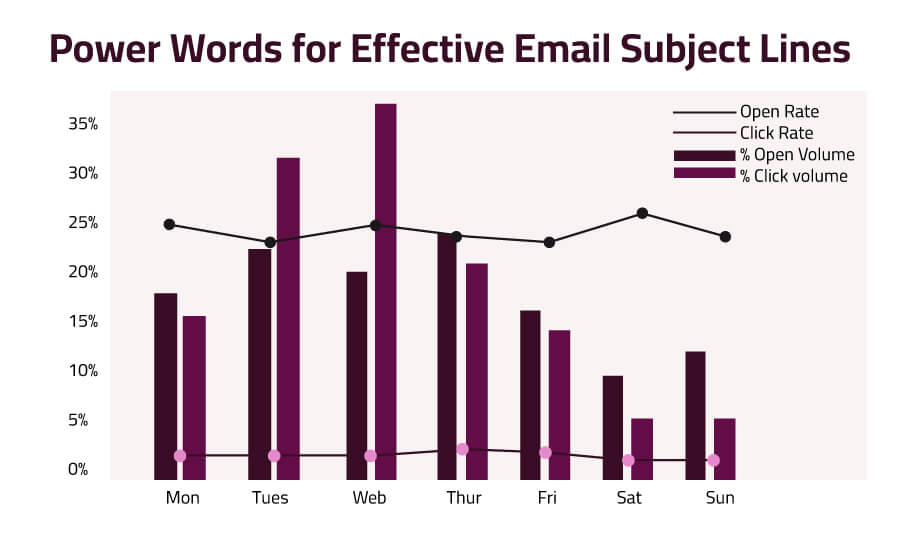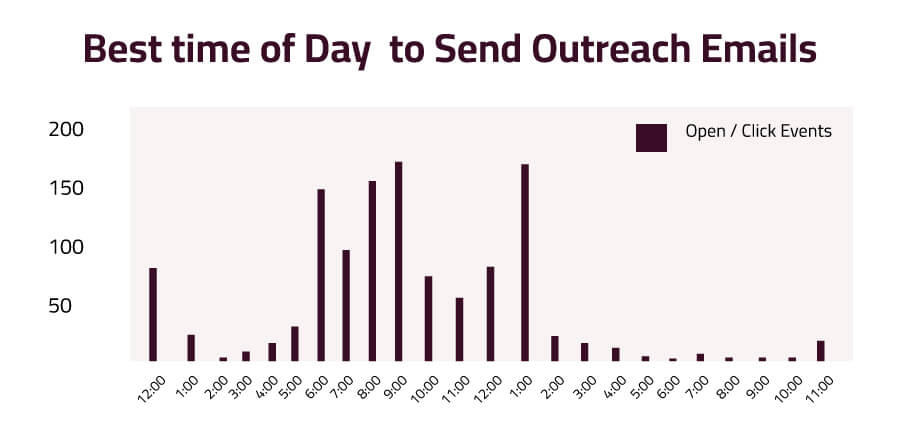
Best Times Sending Cold Emails: When to Hit Send to Get Response
You've meticulously crafted your email – pouring your time and effort into its composition. With a hopeful click, you send it out. Yet, it vanishes without a trace. It remains “Unread by your recipient.”
What’s the reason? Amidst the swirling chaos of the inbox abyss, a key factor often overlooked is the best time to hit the send button.
The timing of sending your emails is critical in whether they are embraced or ignored, read or deleted.
So, when is the opportune moment to send that cold email? The answer is not simple. It's a nuanced interplay influenced by several variables, such as your industry, time zone, and the recipient's locale.
To help you out, we've curated a compendium of optimal times to dispatch those cold emails – drawn from insightful research and industry wisdom.
What Are the Best Times to Send Cold Emails?
The timing of your cold email plays a pivotal role in determining its open rate, ultimately dictating the likelihood of conversions.
Various studies have illuminated the correlation between open rates and email timing. The day of the week impacts open rates, and the hour also influences them.
No matter how finely crafted your message, its potency remains dormant until the recipient's click unlocks it. Let’s explore these elements in more detail:
1. Best Days to Send Cold Emails
Research indicates that weekdays, specifically Tuesday through Thursday, yield optimal results. Why? Individuals are typically engaged in their work routine during these times and are more inclined to check their emails.

Brevo's findings corroborate our claims. The graph shows that weekdays witness the majority of email activity, with 85% of email opens and 95% of clicks occurring during this time.
Outbound emails dispatched on Tuesday and Thursday garner the highest open rates, 19% and 20%, respectively. Wednesday also boasts significant open rates.
Interestingly, emails sent on Wednesdays register the highest click-through rates at 35%, followed closely by those sent on Tuesdays.
The data suggests that individuals are more inclined to take action upon receiving emails on Wednesdays. Brevo posits that email recipients may experience fatigue as the week progresses, potentially diminishing their responsiveness to calls to action.
2. Best Times to Send Cold Emails
Upon examining email engagement metrics for outreach emails, Siege Media uncovered that the prime time to send cold emails falls between 6-9 am PST (9 am-12 pm EST).

Some previous studies advocated for 10 am as the optimal sending time. However, Siege Media observed significant decreases in open and click rates during this hour, for 10 am PST and 10 am EST. As individuals delve into their workday, they initially prioritize more critical and personalized emails, later addressing newsletters and bulk emails around 10 am.
Our Suggestion: To maximize the likelihood of your email being noticed, we advise scheduling delivery between 7-8 am PST. This timeframe capitalizes on the peak in open and click rates experienced between 8-10 am.
3. When to Avoid Sending Emails
Typically, Saturdays and Sundays are the least favorable days for cold email outreach. Potential recipients are likely away from workstations, immersed in family time, or pursuing leisure activities. Hence, they generally avoid engaging with work-related emails.
Furthermore, avoid sending cold emails in the late evening. During these times, your target audience is either sleeping or preparing for their day ahead/winding down.
Instead, aim to dispatch your cold emails during regular business hours. Experimentation and testing can help you pinpoint the specific hour that yields the highest open rates within this timeframe.
4. Best Times and Days to Expect Email Replies
Prospects tend to reply to emails most frequently midweek, particularly on Wednesday. Conversely, replies are least common on Fridays as individuals prepare for the weekend.
Interestingly, we found no clear pattern for the best time of day to expect replies:
- Some recipients respond immediately upon reading emails (5-8 a.m.).
- Others wait until the start of the workday (9 a.m.).
- A significant increase in replies occurs after lunch (2 p.m.).
- Fewer responses are seen toward the end of the workday.
Overall, prospects appear to address emails primarily during the morning hours.
Now that we have answered your primary question, let’s check out some best practices to increase your email’s open rates:
How to Amplify Your Cold Email Responses?
Several factors merit careful consideration when selecting the best time to dispatch cold emails. Here are some key guidelines to ensure your timing aligns with your objectives:
1. Focus on Time Zones
Given the global nature of many businesses, consider your recipients' time zones. Failure to do so may result in emails being delivered inconveniently, undermining their effectiveness.
Certain email marketing platforms offer tools to address this issue. However, you can manually segment your email list in different time zones.
2. Understand Audience Behavior and Demographics
Tailor your email send times to match the habits and preferences of your target audience.
For instance,
- Traditional office hours may be optimal for B2B communications
- Audiences with special interests or younger demographics may prefer to engage with emails during their time, including evenings.
Recognizing these nuances allows you to fine-tune your timing strategy accordingly.
3. Consider Device Usage
The devices your audience uses to access their emails can significantly influence their responsiveness to your communications.
- For individuals relying heavily on smartphones, sending emails throughout the day may yield better results.
- In contrast, those primarily using laptops or tablets may exhibit more predictable patterns. They may check emails during specific times or tasks.
4. Prioritize Email Deliverability
Ensure professionalism in your sender address, craft compelling subject lines, and maintain concise, personalized content. These are essential elements for maximizing engagement and fostering trust with your audience.
Moreover, maintain a clean email list, regularly monitor your sender reputation, and adhere to email authentication protocols.
Additionally, incorporate personalized images and leverage innovative techniques like pattern interrupts. It further enhances the impact of your email campaigns.
By prioritizing email deliverability, you can ensure your messages reach your audience's inbox and drive better results.
5. Focus on Prospect Behavior
Tailor your send times based on individual prospects' specific habits and preferences. Analyze their past interactions with your emails, such as open rates, click-through rates, and response times – to identify patterns.
Understanding when recipients are most active and receptive to emails can help optimize your send times to maximize engagement.
6. Consider Campaign Goals and Content Type
Align email sending times with overarching campaign objectives and the nature of the email content.
For instance, follow-up emails intended to nurture leads or encourage conversions may benefit from being sent at strategic intervals. You can share these communications after a prospect has interacted with previous emails or visited your website.
Similarly, the type of content in an email, whether promotional, informational, or transactional, can influence the optimal send time.
7. Utilize Email Tracking Tools
Monitor open, click, and reply rates to gauge the effectiveness of your email campaigns. Consider leveraging tools like Outreach, SalesLoft, Yesware, Mixmax, Woodpecker, etc.
These tools offer advanced features for outbound email campaigns, including email tracking, automation, and analytics. By monitoring these metrics, you can assess the performance of your emails and adjust your timing strategy accordingly to optimize engagement.
8. Implement A/B/C Testing
A/B/C testing allows you to systematically evaluate the impact of different email templates on performance metrics such as open, click-through, and reply rates.
- Establish a baseline with a standard email template (the control group).
- Gradually introduce slight modifications (A and B templates).
- Monitor the response to each variation to identify which elements contribute to improved engagement.
9. Schedule and Follow Up
Deploy scheduling features within your email marketing platform to automate the delivery of emails at predetermined times.
This capability enables you to capitalize on research insights, such as the increased likelihood of email opens on Tuesdays. It also facilitates strategic follow-up actions.
Conclusion
We reiterate: Timing is critical. Hence, strive to tailor your email timing strategy to your specific audience. Analyze your historical engagement data to gather insights into when your emails generate the most interaction. Combining these insights with industry benchmarks lets you determine the optimal days and times to reach your subscribers' inboxes.
Lastly, stay organized and avoid last-minute rushes. If you need further insights on how to up your cold email strategy, Revnew can help. Contact us now.




